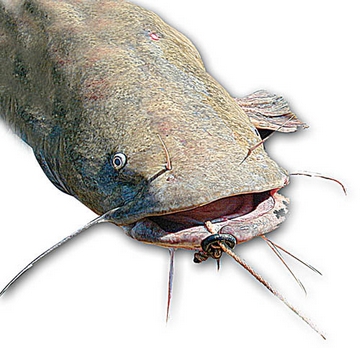All About Catfishposted on 1 January 2008 | posted in Hints and TipsCommon name: Wels catfish Latin name: Silurus glanis Record weight: Weight recognised by the British Record Fish Committee is 62lb caught by Richard Garner from Withy Lake in Bedfordshire in 1997. This fish is unlikely to be ever beaten as although several much larger fish have been caught the record has been suspended. Distribution: Not native to the British Isles, although can now be found in over 150 lakes and rivers in England. Not found in Scotland or Ireland. Native to the River Danube and other large rivers of Eastern Europe where it is known to grow to weights exceeding two hundred pounds. In the last fifty years the wels has been introduced to many fisheries across Europe and has performed particularly well in Italy and Spain, growing to weight approaching two hundred pounds. Now also farmed in Asia for the table. Features: As our only widespread catfish species, the wels is unlikely to be mistaken for any other fish. Could possibly be confused with the rare bullhead catfish which has eight barbules, compared to the six barbules of the wels. Diet: Wels catfish will eat anything small enough to fit into their mouths, although for the most part they appear to feed preferentially on live prey. Despite their small eyes, wels have reasonable eyesight and an exceptional sense of smell and vibration. Their long bodies are covered with pits containing receptors for these two senses maximising the senses. The main pair of barbules are spread wide when hunting forming an extremely sensitive aerial that allows the fish to home in on it's prey. Catfish will also feed on shellfish, crustaceans, amphibians and wild fowl. Spawning: Little is know about the natural spawning of the wels. Each female can produce several million eggs, yet survival is very poor, probably as a result of cannibalism. Spawning takes place at night in June and July when the fish move into shallow weedy water. Growth: Catfish grow incredibly quickly in warm water and can reach a metre in length in only five years and two metres in ten. In the cooler climate of the British Isles catfish grow much more slowly and can take ten years to reach twenty pounds and perhaps another ten years to reach thirty pounds. The main limiting factor in the UK appears to be a lack of suitable food, evidenced by their fast growth in lakes containing large numbers of invertebrates. Little is known about the maximum age of catfish. Certainly, fish approaching forty years of age are known in the UK, although it is said that the fish can live for up to one hundred years. It is likely to take us a considerable time to find out!  Methods of Capture. The most favored method is a legered dead-bait - eels, carp, mullet, roach or skimmer-bream. These can be fished over a ledge, within a channel or cast into the depths in a known haunt. If using live baits, fishing with two trebles is one way also two large single hooks can be used. An alarm system of some description is also advisable. Catfish lie in rugged areas around trees and snags so finding these areas is of great importance. 'Clonking' is one way of getting Catfish into the area, or nearer to your baits, this system requires some pre hand practice to perfect this is easy but do. Try first clonking for about 2 to 5 minutes, then every two hours. Try different depths on moonlight nights and try mostly in the dark nights; daytime is good but only in located areas. |








.jpg)
.jpg)





